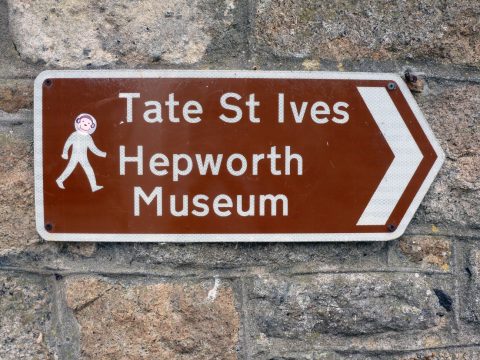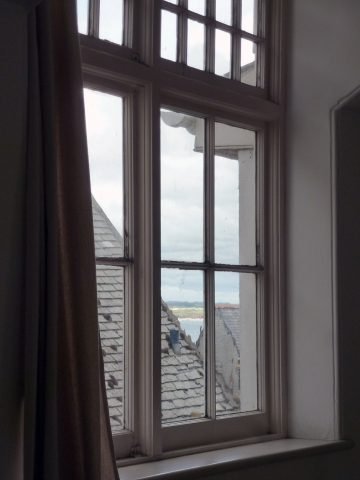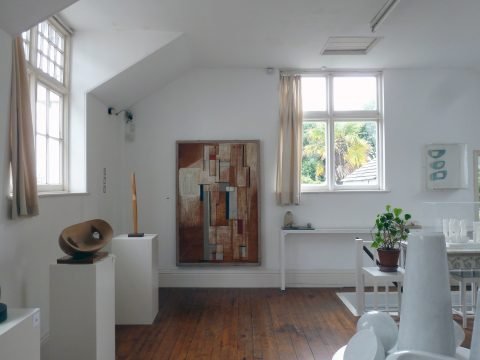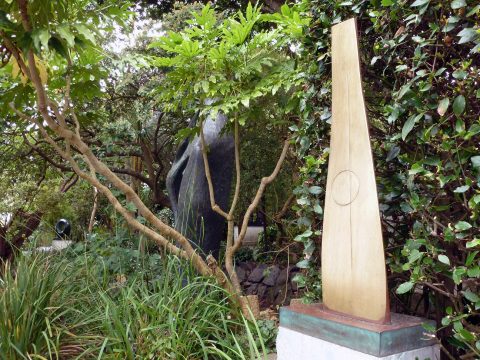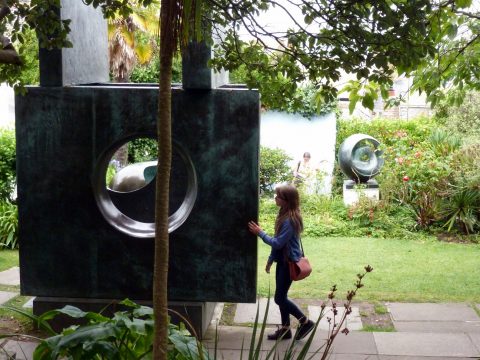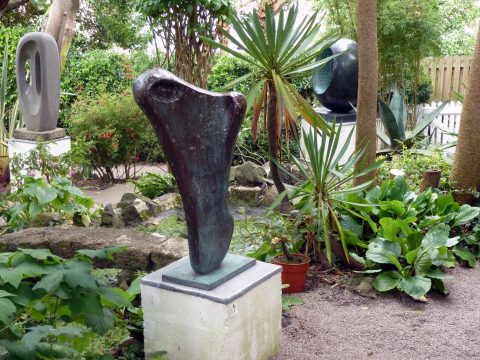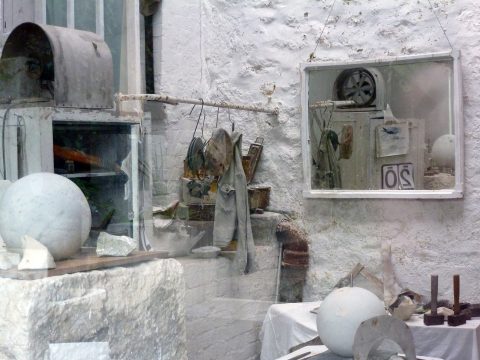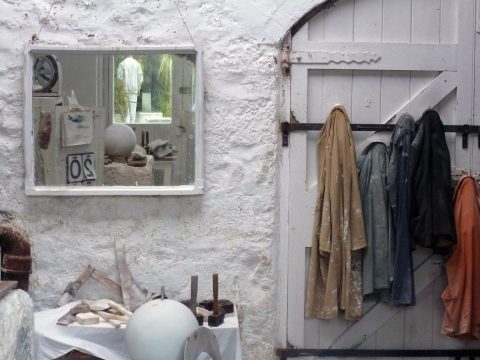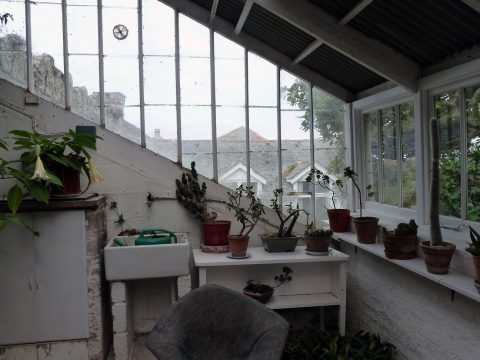Barbara Hepworth Museum, please touch me!
- Barbara Hepworth Museum, exhibition room.
- Barbara Hepworth Museum, exhibition room.
- Barbara Hepworth Museum, sculpture garden,
- Barbara Hepworth Museum, sculpture garden,
- Barbara Hepworth Museum, sculpture garden,
- Barbara Hepworth Museum, the artist’s studio.
- Barbara Hepworth Museum, the artist’s studio.
- Barbara Hepworth Museum, the artist’s studio.
To reference a northern English expression, an anonymous ‘cheeky little monkey’ had attached a cartoon chimpanzee sticker to the figure on the street sign that pointed the way to our destination. Thankfully, just a short walk up Ayr Lane from the impressive Belgrave Gallery, and just a few minutes stroll from Anima Mundi (possibly the two most interesting commercial galleries in St. Ives, amongst a plethora of dubious art outlets) the steepest climb in town is avoided. The main attractions for the art aficionados are the Tate Gallery and the Hepworth Museum. Usefully, being located in a holiday resort, both venues attract visitors from many countries and all social backgrounds. At the Hepworth Museum there is a relaxed atmosphere and, if the essentially organic, modernist sculpture is not your main interest, the sub-tropical garden is worth the visit alone.
The Barbara Hepworth Museum and Sculpture Garden, formerly known as Trewyn Studios, has impressive visitor figures throughout the year. And whilst the Tate St. Ives is closed for a much-needed expansion (it is due to re-open in March 2017), a member of staff confirmed that visitor numbers have increased further at the Museum.
The building on Barnoon Hill initially appears misleadingly small and, were it not for the signage, you might walk past unawares of the treasures within. Hepworth’s former home and studio is situated in a large old house amongst the typically narrow streets. Hepworth herself had passed by for 10 years before becoming aware of its dimensions and suitability for a combined home and sculpture studio – further extended by the distinctive garden. This would be her workspace from 1949 to her untimely death in 1975, aged 72. As she had planned, the property opened to the public soon after her tragic demise, the following year.
Many admirers of Hepworth’s sculpture will have seen her long awaited retrospective show at Tate Britain in 2015. But this exhibition attracted mixed reviews, for example, Alastair Sooke of The Telegraph was frustrated by so many Perspex cases protecting the work. But the London show reminded us that Hepworth was up there with the best British and European artists of the twentieth century.
In contrast to the major retrospective type exhibition, that might easily be missed (how many of us have left it to the last week, or day, to see a show that has been open for two or three months?), the permanent and long-term exposition allows for repeat visits. Also, a lack of pressure to get the most out of that one visit can change the mind-set and make for a more calmer and less formal approach – like visiting a friend over a sustained period of time. Now in its 40th year, this unique location has enabled numerous trips for so many people; and offers a repeat experience for the first-time visitor.
Walking in to the main entrance, we might be entering a version of Doctor Who’s famous Tardis – where a small space defies logic and expands, almost exponentially. Only here, the artifacts to be found are not from science fiction, but are grounded in Hepworth’s humanist connection with the figure and the spaces and structures of land and sea. Furthermore, Hepworth always believed that sculpture was an essentially physical, tactile medium for the viewer, even if that sense of touch could only be made with the eyes, and in close proximity to the work. When her imagination ran wild, it was from the immediate world around her that she memorised and memorialised her sensations into abstract forms.
True to Hepworth’s vision, the Tate curators have preserved the sense of an expansive space, from interior to exterior, expertly. By walking through the house from the ground floor to the garden, via her bedroom, the sense of the property as a complete experience is achieved.
The ground floor was once Hepworth’s kitchen, dining room and bathroom. Today there is a fascinating showcase of memorabilia including quotations by Hepworth, plus photographs and catalogues from the collection of Alan Bowness (her son-in-law). This includes the Venice Biennale catalogue of 1950 when the British Council presented her work with John Constable and Matthew Smith. In this vestibule the first large sculpture is displayed, surrounded by the tools of her trade, to contextualise her working practice and add an educational aspect to the project.
Ascending a staircase, what was the largest living space has the appearance and quality of a collector’s living room, rather than of a standard gallery or museum display. There are many sculptures on show here, and also a bronze cast of the sculptor’s hand. Wall space is limited because of the windows, although, ‘Two Figures (Heroes)’ [1954], offers a cubist-constructivist type image that references her allegiance with the international avant-garde of the 1930s. At this time, with her second husband Ben Nicholson, she had met Picasso, Brancusi and Jean Hélion amongst others. In this room we see her last major sculpture – the white marble, ‘Fallen Images’ [1974-5], displayed on a circular wooden plinth in the centre of the room. This work appears to recall the abstracted, painted, forms of Hélion. A relatively small work, ‘Oval with Two Forms’ [1971], a womb-like marble form on a slate base, is displayed adjacent to this and many other pieces, and suggests abstract forms within a larger body. This echoes the associations of her work to Henry Moore’s – arguably her only rival in the field of British sculpture in her lifetime.
Time spent in this display space alone would have made our visit worthwhile – but there was still the garden. Here the Tate curators have maintained, and exploited, the open-air and near woodland aspects of the magnificent sculpture-garden. A surprisingly physical relationship with the works on display is achieved by ensuring that there is an intimacy of arrangement and accessibility. The continued curation of the garden, where the viewer can approach most of the sculptures from any vantage point and get very close, succeeds through not appearing overly or specially arranged. The works are placed where we might have put them ourselves. In fact the physical experience of walking around and within the outside space, where there is not an insistent or regimented gallery controlled order of viewing, breaks down the kind of straight-jacket imposition that many gallery interiors induce to direct our encounter.
Intriguingly, Hepworth’s attitude with regard for the necessity to handle sculpture might worry curators and security staff alike, as she once stated:
“Everything I make is to touch, and people usually do, which pleases me. And it’s very important to a sculptor…. So the real thing for people is to move with their bodies. If I’ve made them do that, then I’m very happy!”
(Quotation from Tate Shots video)
But, out of respect (and convention), very few people touched the work during our visit. Oddly enough, you did not need to – particularly as the trees and other plants satisfied any tactile requirement.
Within the garden there is a circuitous route that you can make, clock-wise or anti-clockwise, in just 80-90 paces. Then it’s 20 or so steps through the middle of this oval. There is a bench in the centre and another on one side, should you need to rest. More likely, visitors will sit or stand, simply to absorb the sculptures and plants and to enjoy the forms of both. Moving around, you create your own momentum and stop-start rhythm – with many visitors making the journey several times in a variety of patterns. At the end of two or three circuits you might think you have had a walk in the countryside, for the view towards the sea over rooftops that Braque or Picasso might have painted in their proto-Cubist days, takes the mind’s eye out of this enclosed space.
Feeling like a bonus extension to the visit, looking in to the carving and plaster studios attached to the house brings the visitor back to the gallery convention of the showcase. Understandably we cannot enter, but the windows allow a clear viewing of the contents. The carving studio, essentially for stone, has been preserved almost as it was when Hepworth died. Work clothing still hangs from a large door, formerly accessed from a side road. Outside this studio, where we stand, there are blocks of stone made ready to work on – perhaps they were delivered only last week and put into place by the assistants yesterday? Conceptually, these suggest a state of continuity, as sculptures yet to be made. And in the plaster studio, which also retains a sense of still being in use, we see various tools that could have been left as they are the day before. Although, giving a clue to the subtle curatorship, the floor is well swept which hints at the implied theatricality of the scene. Of course, the garden showcases too, but with the element of a more participatory, physical engagement that would have appealed to Hepworth.
Unlike the main Tate attraction in St. Ives, the Barbara Hepworth Museum and Garden is not in need of expansion at all. But, with the recent gift of Hepworth’s former, and larger workspace, the Palais de Danse studio (formerly a cinema and dance hall) opposite the house, there is an opportunity for further development of the complex. Like the numerous day-trippers, families on holiday and art lovers, we shall have to re-visit at a future date.
Let us hope that all those cheeky little monkeys enjoyed their visit as much as we did – and they return with their own children one day.
Note:
If you are in London this month be sure to visit Philips European headquarters in Berkeley Square where a non-selling exhibition, ‘Late Hepworth’, is curated by The Hepworth Wakefield with Philips. The works will be on display as part of a year-long partnership. This show explores the final decade of Barbara Hepworth’s career, showcasing her experimentation with a wide variety of media and materials.
August 5, 2016

